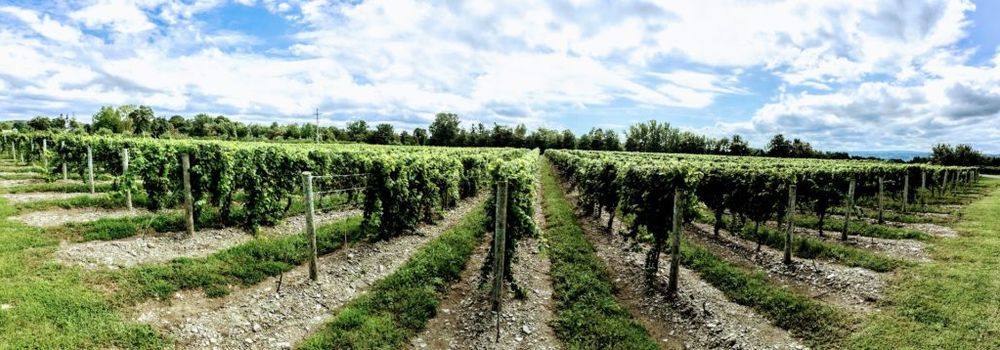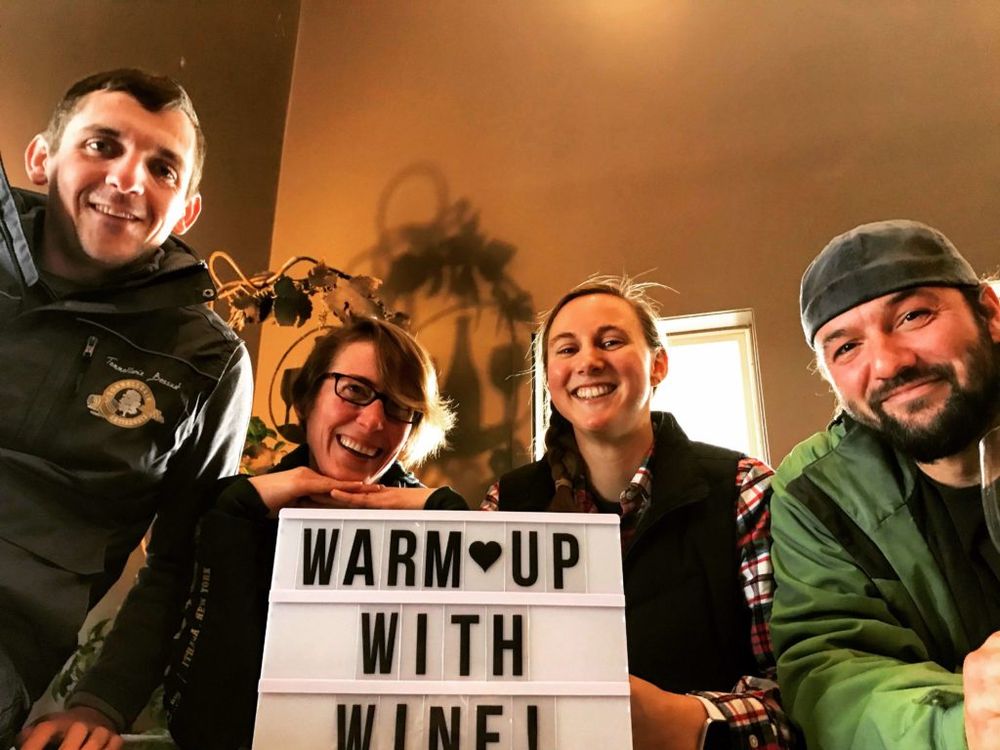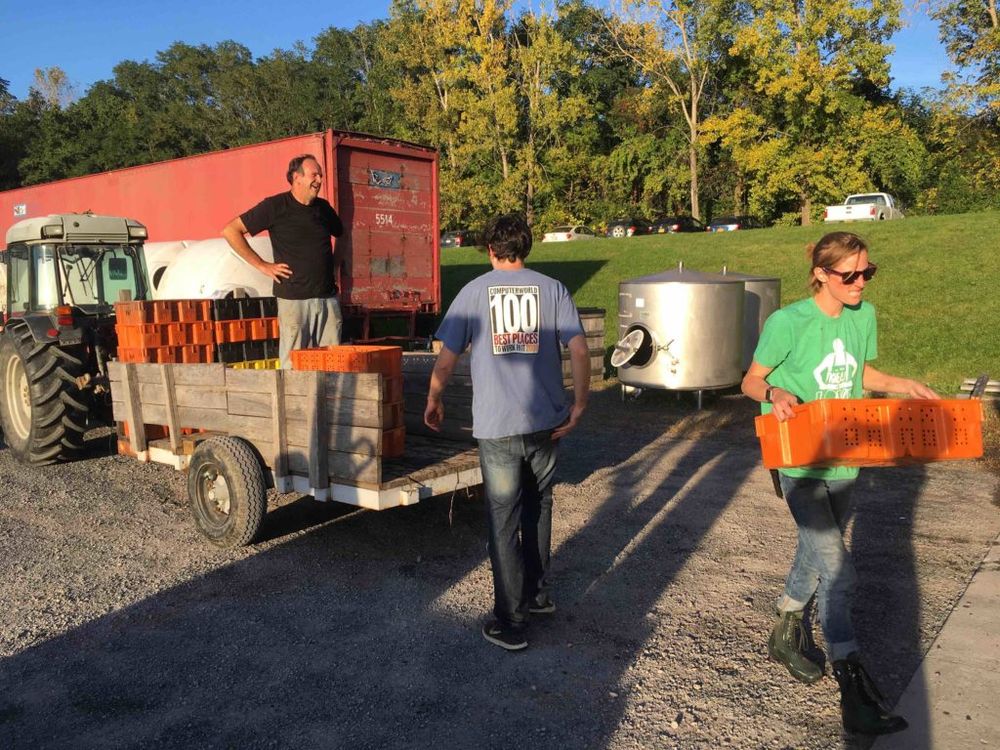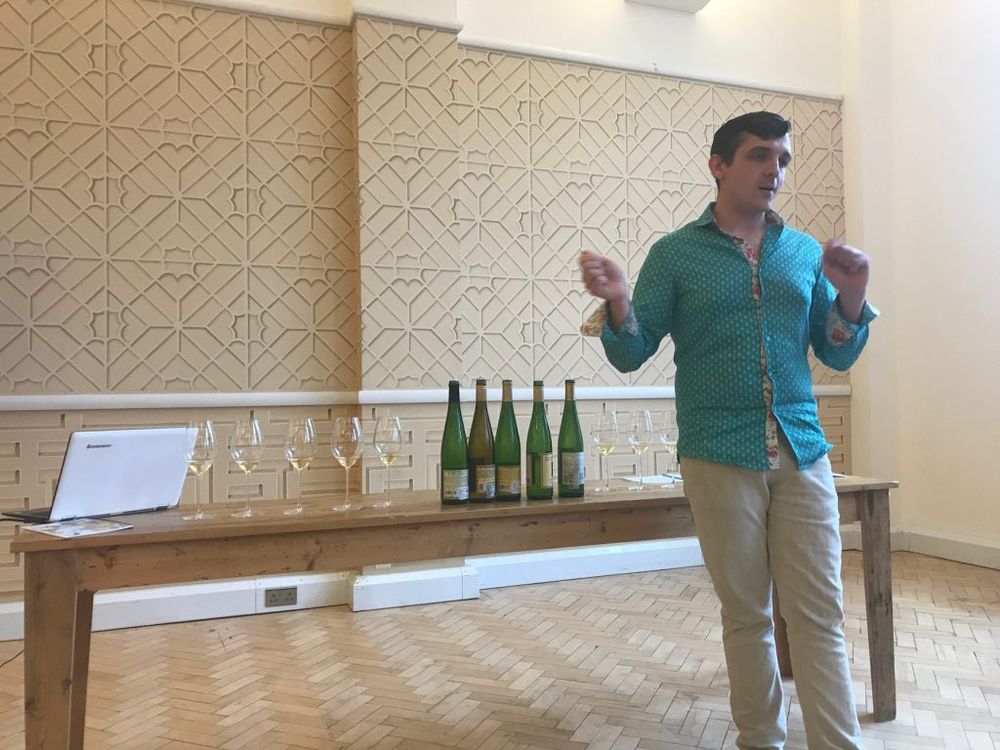Red Newt Cellars was established in 1998 by David and Debra Whiting and has gone on to make wines from it own vine as well as working with growers around Seneca Lake on long term contracts. Kelby Russell joined its team in 2012, and has brought a new style of winemaking, with a particular focus on indigenous yeasts, and pushing as far as he can the kinds of wines it is possible to make in the Finger Lakes. So much so that an average harvest now sees 70 or so different lots of Riesling fermenting in the cellar in a manner of styles, from skin contact, to barrel aged, to under flor.
Here Kelby Russell explains his philosophy of winemaking and what he wants to bring to the Red Newt style.
Tell us about yourself and the winery?

Red Newt is situated on shale soils and with a cool climate ideal for growing Riesling and Cabernet Franc in particular
Red Newt Cellars has joyfully produced Riesling and Cabernet Franc from Seneca Lake since 1998. With a full suite of Rieslings, from dry to dessert, and several Cabernet Franc bottlings every harvest I look to embrace the single vineyard ethos that I inherited from founding winemaker David Whiting. I hope to push the envelope with spontaneous fermentations, lees contact, cold soaking, and basket pressing. Red Newt’s wines are designed to open up in bottle for years to come.
What grapes do you grow and why?
Red Newt’s production is overwhelmingly committed to Riesling, a grape that constitutes 75% of our production and 10 or more separate bottlings in any given vintage. Of the remaining 25%, Cabernet Franc makes up the majority, with Gewürztraminer, not far behind.
While Pinot Noir, Pinot Gris, and even Syrah find their way at Red Newt, Riesling and Cabernet Franc are the grapes that consistently and transparently express our soil and vintage most readily in the Finger Lakes.
What makes your particular region suitable for those grapes and what sort of styles of wine do do you like to make?
The shale soils, steep slopes, and cool continental climate moderated by deep lakes make Red Newt’s vineyard sites ideal for growing Riesling in particular. Crisp, rich, aromatic grapes are the result of this combination; and as a Riesling specialist, Red Newt cannot help but make multiple styles from dry to dessert to show off the diversity of Riesling on our soils.

Kelby, left, with some of the winemaking team at Red Newt
While a less common companion grape for Riesling, Cabernet Franc also thrives on the sun-drenched slopes of Seneca Lake. An emerging classic in the Finger Lakes, the grape ripens wonderfully for styles from Rosé to fruit-forward and crunchy red to barrel reserve.
What is your approach/philosophy to winemaking and has that changed at all in recent years?
Red Newt’s winemaking philosophy has always placed vineyard expression first and foremost, particularly with grapes like Riesling that are so terroir expressive. We are fortunate to have a remarkably beautiful and diverse set of vineyards to work with, and it has been a pleasure to make wines that show those distinctions.
In recent years,I have looked to showcase the strength of our vineyards in producing richer, more textured styles of wine. Spontaneous fermentations, cold soaking, long lees ageing, no fining any of our wines or filtering the reds, and even a fair amount of wooden basket pressing; these are all changes ‘under the cork’ at Red Newt that have made our wines more age-worthy and classic, without changing their specific vineyard heritage.
What would you say are the big points of difference – the USPs of New York wine that buyers should know?
As wine tastes go, what was once the Finger Lakes’ largest liability has now become a strong suit: our cool climate. Winemaking in a cool climate is already a risky proposition, the threats of winter kill, spring frost, and too cool of a growing season to ripen the grapes always loom. Add onto that a market push in the 2000s for bigger bodied styles, and even selling Finger Lakes wines was an uphill battle.

Conditions are tough throughout the winter and only the strongest varieties can survive the long winters
In recent years, however, the market has rapidly evolved to appreciating wines of greater finesse, and especially wines that reach full flavour maturity at more approachable alcohol levels. Rather than having to apologise for a Cabernet Franc at 12.5%, its sought out as a positive, as a sign of food-friendliness and our specific terroir.
With global warming, cool climates are becoming harder and harder to find. For all its challenges, we’re glad that we find ourselves in a quintessential example of one.
What are the main markets for your wine – in the US and for export?
Red Newt’s main market has expanded in the past decade from our home region outward to a main ‘region’ now extending from Chicago to Boston to Washington D.C. While our wines are sold across the United States, exports to China, the UK, and the EU have all been going up.
What percentage is now for export – is that growing? If so which countries are you targeting for growth?
Currently, 5% of Red Newt’s annual sales are via the export market, but that is a number that has been increasing at a marked rate in the past three years. China remains a market of great potential for the wines, but the UK has risen to the top of our export strategy in the past 18 months. For reasons that may be hard to define, there is a notable synergy between Red Newt’s expression of dry Rieslings and the UK’s critical and consumer market.
What are the types of wine in your portfolio that work best in export and why?
To our surprise – and delight! – our export market success has come primarily through our classic and Single Vineyard expressions of Riesling, Cabernet Franc, and Pinot Noir. That is to say, the most successful wines come from the middle and top of our production pyramid, as opposed to the entry-level bottlings that are our domestic foundation.
Riesling wise, there are many possible reasons for why the Finger Lakes entry-level style isn’t as easy a sell internationally; residual sugar chief amongst them. For our mid and upper tier Rieslings, however, their success is easy to see on a wine list or off-trade shop: quality and value. Red Newt’s top tier Rieslings stand proudly on a global stage, but for the time being our price comes in notably below what would be considered our cohort from Germany, Austria, or Australia.
Meanwhile, Cabernet Franc and Pinot Noir are arguably more successful in export than domestically for us! In visiting London to show the wines it was clear that the UK market has much greater familiarity with, and appreciation for, both of those grapes and the old world manner in which we work with them.

Picking grapes is an intricate affair with so many different ferments taking place
What do you think of the UK market and why do you want to sell your wines here?
The UK market has been an absolute delight to be in and explore expanding upon! While I have an affinity for the UK born out from a summer working with the Royal Philharmonic in Liverpool, it has been rewarding to see such a warm and enthusiastic response to our wines in return.
London is renowned for being a difficult market, let alone expanding beyond that throughout the UK, and yet our wines seem to make waves whenever they are shown. I must admit that I am not entirely sure why that is, other than to note that sometimes a market’s palate and understanding of a grape lines up nearly perfectly with your own. Whatever the reason, our handling of Rieslings in particular seems to strike a nerve, and I look forward to being back to share my own passion for them.
What type of partners are you looking for in your export markets?
Red Newt has limited vineyard space to work with in the soil types and sites we prefer, and our philosophy is to remain within them, doing what we do best. While that means we can internally shift production between some wine styles, our aim is not to grow overall production. That focus suits us best. In looking at markets, it means we also aim to find advocates for the Single Vineyard expressions we believe in and customers that will appreciate it.
Our dry Rieslings take time to open up and lean towards the mineral and powerful end – they are not to everyone’s liking. So in our preference to find partners that are excited by our ‘voice’, the implication is usually off-premise stores and restaurants that are ready to explain our wines by hand to customers that love Riesling or are excited to try something new that will move them.

“It’s winemaking on a knife’s edge”: Red Newt’s winemaker Kelby Russell at a London tasting in June 2018
How have you been able to cope and react to the Covid-19 outbreak?
Red Newt is fortunate to have a loyal regional following and wine club during these trying times, and it is thanks to both of those factors that CoVid’s impacts are thus far minimal. While we joke about the wine industry being recession-proof, the truth is that reasonably priced and well made wines always find a home. So even if we are unable to be out in the market with our wines, the wine store market in particular is finding the wines at near-record rates.
In our facility, the cellar team continues to work away on the wines and ferments while maintaining appropriate social distancing. The Tasting Room and Bistro are both closed for the moment, but our staff in both are keeping busy with shipping orders and brainstorming what comes next.
What specific steps and activities have you put in place?
Along with the virtual tastings and shipping specials that all wineries have been adopting, Red Newt has been opening up our vault. Thanks to our own library of wines, as well as the Bistro’s legendary holdings of vintage wines from producers around the region, Red Newt’s cellar has a remarkable wealth of Finger Lakes wine history available. It has been a pleasure to be able to offer these wines to customers new and old, as well as talk about the past 15-20 vintages in the Finger Lakes via them.
Beyond these direct responses, we’re eager to use the ‘break’ of this period to rethink and evolve our Tasting Room experience for guests. The Finger Lakes has changed a remarkable amount in the past 15 years, most notably in the tourist base and their increasing sophistication. While Red Newt has always believed in hospitality first, this has presented us an opportunity to create even more tailored tasting and visit experiences.










































